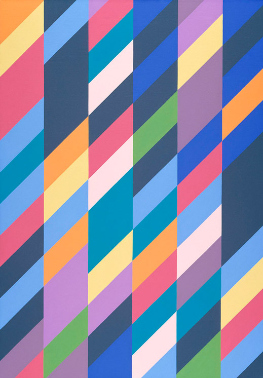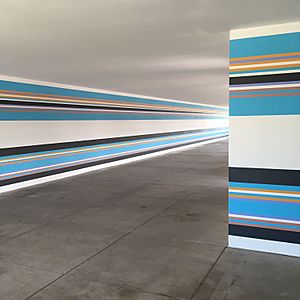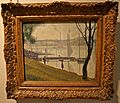Bridget Riley facts for kids
Quick facts for kids
Bridget Riley
|
|
|---|---|
| Born |
Bridget Louise Riley
24 April 1931 Norwood, London, England
|
| Education |
|
| Known for | |
| Movement | Op art |
| Awards |
|
Bridget Louise Riley (born on April 24, 1931) is a famous English painter. She is best known for her amazing op art paintings. Op art uses shapes and colors to create illusions of movement. Bridget Riley lives and works in London, Cornwall, and a region in France called Vaucluse.
Contents
Early Life and Art Training
Bridget Riley was born in Norwood, London, in 1931. Her father, John Fisher Riley, was a printer. In 1938, his printing business moved to Lincolnshire, and the family went with him.
When World War II began, her father joined the army. Bridget, her mother, and her sister Sally moved to a small house in Cornwall. Bridget went to Cheltenham Ladies' College from 1946 to 1948. After that, she studied art at Goldsmiths' College (1949–1952) and the Royal College of Art (1952–1955).
From 1956 to 1959, Bridget cared for her father after he was in a serious car accident. This was a very tough time for her. Later, she worked in a shop that sold glassware. She also worked part-time as an illustrator for an advertising company until 1962. Seeing an exhibition of paintings by Jackson Pollock in 1958 really inspired her.
At first, Bridget's art looked more like real-life pictures. Then, she started using a style called Pointillism, where artists use tiny dots of color. In 1959, she met an art teacher named Maurice de Sausmarez. He became a good friend and helped her learn about different art styles like Futurism. They painted together in Italy in 1960. During this trip, she painted Pink Landscape (1960), which used the pointillist style.
After this, Bridget began to create her unique Op Art style. She used black and white geometric patterns. These patterns make your eyes feel like they are moving and create a sense of color, even when there isn't any. She and Maurice de Sausmarez remained friends until he passed away in 1969.
Bridget also taught art to children from 1957 to 1958. She later taught at other art schools, including Loughborough School of Art (1959) and Croydon College of Art (1962–1964).
In 1961, Bridget and her partner Peter Sedgley visited France. They bought an old farm and turned it into an art studio. In 1962, she had her first solo art show in London. In 1968, Bridget, Peter Sedgley, and a journalist named Peter Townsend started an organization called SPACE. Its goal was to help artists find large, affordable places to work.
How Georges Seurat Influenced Her Art
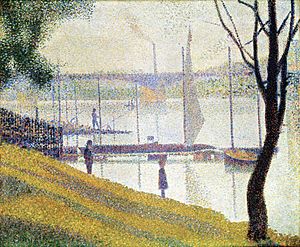
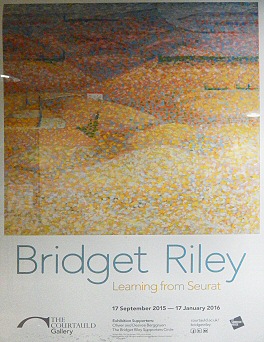
Bridget Riley's art style, which became famous in the 1960s, was inspired by artists like the French painter Georges Seurat. Seurat was known for his Neo-Impressionist style, which used tiny dots of color.
In 2015–2016, an art show called "Bridget Riley: Learning from Seurat" showed how Seurat's dot-painting style influenced Riley's abstract art. In 1959, when she was a young artist, Riley saw Seurat's painting The Bridge at Courbevoie. She decided to paint her own copy of it. This copy has been in her studio ever since.
Art critics say that Riley learned a lot from Seurat about how colors and shapes affect our eyes. She studied how Seurat used different colors next to each other to create a certain look. This helped her develop her own unique way of making art that plays tricks on your eyes. Her painting Pink Landscape (1960) shows this influence. It looks like a sunny scene from Italy, painted with many small dots of color.
Her Famous Artworks
Bridget Riley first became known for her black and white paintings. These artworks use many different geometric shapes to create a feeling of movement or even color. When people looked at her early 1960s paintings, they sometimes felt dizzy or like they were floating!
From 1961 to 1965, she focused on black and white, sometimes adding shades of gray. Her first solo show in 1962 featured these types of works. For example, in her painting Fall, she repeats a curved line to create a pattern that seems to vibrate. These paintings made viewers feel like they were part of the art.
Bridget Riley carefully plans her paintings using drawings and collages. Then, her assistants paint the final large canvases with great care, following her instructions.
In 1967, Riley started using color in her art. She created her first stripe painting that year. After a big art show in the early 1970s, Riley traveled a lot. A trip to Egypt in the early 1980s inspired her. She saw colorful hieroglyphic designs and began to use bright colors and strong contrasts in her own work. In some of her paintings, lines of color create a shimmering effect. In others, the canvas is filled with repeating patterns. Shadow Play is a good example of her colorful later works.
Some of her paintings are named after dates, while others are named after places, like Les Bassacs, a village in France where she has a studio.
After her trip to Egypt in 1980–1981, Riley created what she called her 'Egyptian palette' of colors. She made series of paintings like the Ka and Ra series. These paintings capture the feeling of Egypt, both ancient and modern, and show the colors of the Egyptian landscape. In 1983, Riley went back to Venice to study famous European paintings and their use of color.
By the late 1980s, Riley's art changed again. She started using diagonal shapes, like parallelograms, to break up the vertical stripes she had used before. In Delos (1983), for example, she used blue, turquoise, and green colors mixed with bright yellows, reds, and white.
Large Wall Paintings
Bridget Riley has created large wall paintings, also known as murals, for famous art galleries like the Tate and the National Gallery. In 2014, she was asked to create a permanent 56-meter mural for St Mary's Hospital, London. This artwork is on the 10th floor of the hospital.
Between 2017 and 2019, Riley completed a very large wall painting for the Chinati Foundation in Marfa, Texas. This was her biggest work yet, covering six walls of a building. This mural was inspired by her earlier work called Bolt of Colour from 1983 and used similar Egyptian-inspired colors.
Writer and Curator
Bridget Riley has also written about other artists. She helped organize art exhibitions, including "Piet Mondrian: From Nature to Abstraction" at the Tate Gallery in 1996. In 2010, she chose a special collection of large figure paintings by famous artists like Titian and Paul Cézanne for an exhibition at the National Gallery in London.
Art Exhibitions
In 1965, Bridget Riley's work was shown in a very important exhibition in New York City called The Responsive Eye. This show brought her art, and the Op Art movement, to worldwide attention. Her painting Current (1964) was even on the cover of the exhibition's catalog.
Riley's art was also shown at major international art events like documenta in 1968 and 1977. In 1968, she represented Great Britain at the Venice Biennale, a huge art exhibition. She was the first British contemporary painter and the first woman to win the International Prize for painting there!
In 1999, a show of her early paintings at the Serpentine Gallery sparked new interest in her optical art. Major exhibitions of her work have been held at places like Tate Britain (2003), the National Gallery (2010–2011), and the David Zwirner Gallery in London (2014).
A big exhibition of her work, covering her 70-year career, was shown at the Scottish National Gallery and the Hayward Gallery from 2019 to 2020. In 2021, her work was part of the "Women in Abstraction" exhibition in Paris. In May 2023, her first ceiling painting, Verve, was shown at The British School at Rome.
Public Collections
Many museums and galleries around the world own Bridget Riley's artworks. Some of these include:
- Art Institute of Chicago
- Museum of Modern Art, New York
- Tate, London
- Scottish National Gallery, Edinburgh
- Walker Art Gallery, Liverpool
- Museum Boijmans Van Beuningen, Rotterdam
- Moderna Museet, Stockholm
- Dallas Museum of Art
- Hammer Museum, Los Angeles
- National Museum Cardiff, Amgueddfa Cymru – Museum Wales
Influence on Other Artists
Other artists, like Ross Bleckner and Philip Taaffe, have created paintings that honor Bridget Riley's work. In 2013, Riley said that a large black-and-white artwork by Tobias Rehberger looked too much like her painting Movement in Squares. She asked for it to be removed from display.
Awards and Honors
Bridget Riley has received many awards for her art.
- In 1963, she won the AICA Critics Prize.
- In 1968, she received the International Painting Prize at the Venice Biennale.
- In 1974, she was made a Commander of the Most Excellent Order of the British Empire (CBE).
- She has received special honorary degrees from Oxford University (1993) and Cambridge University (1995).
- In 2003, she was given the Praemium Imperiale, a very important international art award.
- In 1998, she became one of only 65 Members of the Order of the Companions of Honour in the Commonwealth.
- In 2012, she became the first woman to receive the Sikkens Prize, a Dutch art award that recognizes the use of color.
As a board member of the National Gallery in the 1980s, she helped make sure that a new part of the museum, the Sainsbury Wing, could be built.
Helping Others Through Art
Bridget Riley supports Paintings in Hospitals, a charity that provides art for hospitals and care centers in England, Wales, and Northern Ireland.
Between 1987 and 2014, she created three murals for St Mary's Hospital, London. Since 2016, the Bridget Riley Art Foundation has helped fund a special art fellowship at the British School at Rome. In 2017, she donated artworks to an auction to raise money for Modern Art Oxford.
Images for kids
See also
 In Spanish: Bridget Riley para niños
In Spanish: Bridget Riley para niños


